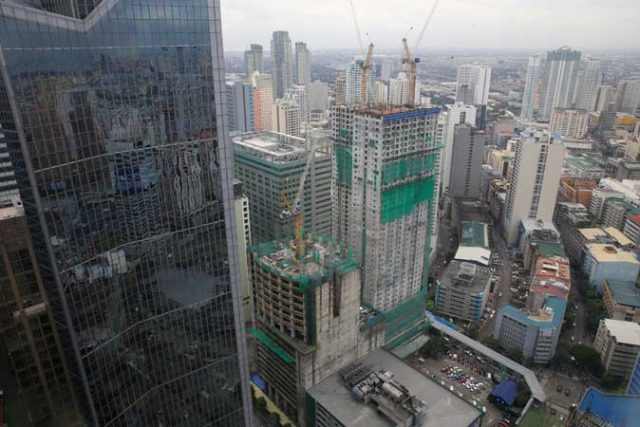
Big Philippine banks lend less amid rising bad loans – BusinessWorld

By Lourdes O. Pilar, Researcher
THE FIRST three months of the year saw the country’s biggest banks issuing even fewer loans as soured loans piled up amid the coronavirus pandemic.
The first-quarter edition of BusinessWorld’s Quarterly Banking Report showed the aggregate loans of 46 universal and commercial banks (U/KBs) declined by 5.98% year on year to P9.351 trillion in the January-March period, sharper than the 3.96% contraction posted in the preceding quarter.
The reduction in loans in the first quarter marked the sharpest since the first quarter of 2003 when loans lent by U/KBs fell by 9.84%. The latest reading brought the losing streak in loans to three consecutive quarters.
The quarter also saw bad loans, also known as nonperforming loans (NPL), rise by 17.2% year on year to P361.892 billion from P308.832 billion in the fourth quarter of 2020. Compared with the same period last year, soured loans grew by almost 70%.
This brought the NPL ratio — or the bad loans as a portion of the total loan portfolio — to 4.12% in the first quarter, surpassing the record-high NPL ratio of 3.68% in the fourth quarter of 2020 based on new reporting standards introduced by the Bangko Sentral ng Pilipinas (BSP) in the first quarter of 2013.
Loans are classified as nonperforming when they are left unpaid at least 30 days beyond the due date. They are considered as a risk to the lenders’ asset quality as borrowers are likely to default on these debts.
Meanwhile, the combined assets of big banks grew by 5.84% to P18.878 trillion in the first quarter, from P17.837 trillion in the same three months last year. This was slightly faster than the 5.6% expansion in the fourth quarter of 2020, but still slower compared with the 7.06% in the same period last year.
Profitability in the first quarter improved from the preceding quarter as the median return on equity (RoE) was tallied at 3.89% from 3.66%. However, this was still lower than the RoE of 5.17% in the first quarter of 2020.
The RoE ratio measures the amount that shareholders make on every peso they invest in a firm and is calculated by dividing the net profit to average capital. It also measures how well a firm makes use of the money from shareholders to generate income.
BDO Unibank, Inc. remained the biggest bank in terms of assets with P3.334 trillion. State-owned Land Bank of the Philippines (LANDBANK) came in at second with P2.409 trillion, overtaking Metropolitan Bank & Trust Co.’s (Metrobank) P2.374 trillion and the Bank of the Philippine Islands’ (BPI) P2.151 trillion.
BDO remained on top in terms of loans issued with P2.144 trillion, followed by BPI’s P1.359 trillion and Metrobank’s P1.134 trillion.
Among banks with assets of at least P100 billion, the Development Bank of the Philippines (DBP) once again posted the fastest year-on-year asset growth with 44.33%. It was followed by the Bank of Commerce and Robinsons Bank Corp. with 29.39% and 27.73% growth, respectively.
DBP likewise saw the fastest growth in loans, with a year-on-year expansion of 11.93%, followed by Robinsons Bank (10.71%) and Rizal Commercial Banking Corp. (5.70%).
BDO had the most deposits with P2.633 trillion, followed by LANDBANK with P2.124 trillion and Metrobank with P1.739 trillion.
ASSET QUALITY DECLINES
Latest figures show a deterioration in asset quality in the first quarter. For instance, the nonperforming asset ratio — or the NPLs and foreclosed properties in proportion to total assets — worsened to 1.38% in the first quarter from 1.17% in the fourth quarter.
Relative to total assets, foreclosed real and other properties remained unchanged at 0.28% in the first quarter compared with the previous quarter.
Total loan loss reserves among U/KBs reached P325.228 billion in the first quarter, bigger than the P322.568 billion in the fourth quarter.
While the banks’ median capital adequacy ratio (CAR) of 19.78% in the first quarter remained above the required minimum of 10% set by the BSP and the international standard of 8%, this was a tad lower than the 20.14% logged in the previous quarter. CAR measures the ability of banks to absorb losses from risk-weighted assets.
BusinessWorld Research has been tracking the financial performance of the country’s big banks on a quarterly basis since the late 1980s using banks’ published statements.
The full version of BusinessWorld’s quarterly banking report will soon be available for download on www.bworldonline.com.
Stay connected with us on social media platform for instant update click here to join our Twitter, & Facebook
We are now on Telegram. Click here to join our channel (@TechiUpdate) and stay updated with the latest Technology headlines.
For all the latest Education News Click Here
For the latest news and updates, follow us on Google News.


